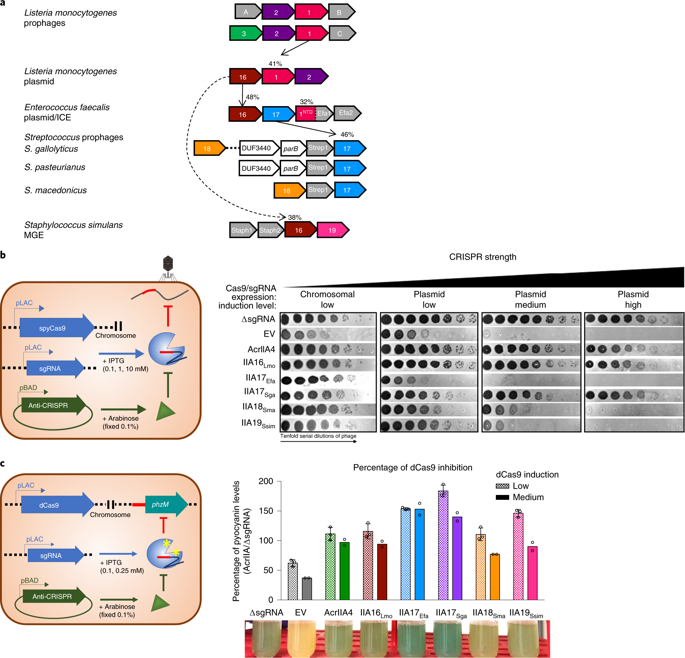当前位置:
X-MOL 学术
›
Nat. Microbiol.
›
论文详情
Our official English website, www.x-mol.net, welcomes your feedback! (Note: you will need to create a separate account there.)
Broad-spectrum anti-CRISPR proteins facilitate horizontal gene transfer.
Nature Microbiology ( IF 28.3 ) Pub Date : 2020-03-26 , DOI: 10.1038/s41564-020-0692-2 Caroline Mahendra 1 , Kathleen A Christie 2, 3, 4 , Beatriz A Osuna 1 , Rafael Pinilla-Redondo 1, 5, 6 , Benjamin P Kleinstiver 2, 3, 4 , Joseph Bondy-Denomy 1, 7, 8
Nature Microbiology ( IF 28.3 ) Pub Date : 2020-03-26 , DOI: 10.1038/s41564-020-0692-2 Caroline Mahendra 1 , Kathleen A Christie 2, 3, 4 , Beatriz A Osuna 1 , Rafael Pinilla-Redondo 1, 5, 6 , Benjamin P Kleinstiver 2, 3, 4 , Joseph Bondy-Denomy 1, 7, 8
Affiliation

|
CRISPR-Cas adaptive immune systems protect bacteria and archaea against their invading genetic parasites, including bacteriophages/viruses and plasmids. In response to this immunity, many phages have anti-CRISPR (Acr) proteins that inhibit CRISPR-Cas targeting. To date, anti-CRISPR genes have primarily been discovered in phage or prophage genomes. Here, we uncovered acr loci on plasmids and other conjugative elements present in Firmicutes using the Listeria acrIIA1 gene as a marker. The four identified genes, found in Listeria, Enterococcus, Streptococcus and Staphylococcus genomes, can inhibit type II-A SpyCas9 or SauCas9, and are thus named acrIIA16-19. In Enterococcus faecalis, conjugation of a Cas9-targeted plasmid was enhanced by anti-CRISPRs derived from Enterococcus conjugative elements, highlighting a role for Acrs in the dissemination of plasmids. Reciprocal co-immunoprecipitation showed that each Acr protein interacts with Cas9, and Cas9-Acr complexes were unable to cleave DNA. Northern blotting suggests that these anti-CRISPRs manipulate single guide RNA length, loading or stability. Mirroring their activity in bacteria, AcrIIA16 and AcrIIA17 provide robust and highly potent broad-spectrum inhibition of distinct Cas9 proteins in human cells (for example, SpyCas9, SauCas9, SthCas9, NmeCas9 and CjeCas9). This work presents a focused analysis of non-phage Acr proteins, demonstrating a role in horizontal gene transfer bolstered by broad-spectrum CRISPR-Cas9 inhibition.
中文翻译:

广谱抗 CRISPR 蛋白促进水平基因转移。
CRISPR-Cas 适应性免疫系统可保护细菌和古细菌免受其入侵的遗传寄生虫(包括噬菌体/病毒和质粒)的侵害。为了响应这种免疫,许多噬菌体具有抑制 CRISPR-Cas 靶向的抗 CRISPR (Acr) 蛋白。迄今为止,主要在噬菌体或原噬菌体基因组中发现了抗 CRISPR 基因。在这里,我们使用李斯特菌 acrIIA1 基因作为标记发现了存在于厚壁菌门中的质粒和其他接合元件上的 acr 基因座。在李斯特菌、肠球菌、链球菌和葡萄球菌基因组中发现的四种鉴定基因可以抑制 II-A 型 SpyCas9 或 SauCas9,因此命名为 acrIIA16-19。在粪肠球菌中,来自肠球菌结合元件的抗 CRISPR 增强了 Cas9 靶向质粒的结合,强调 Acrs 在质粒传播中的作用。互惠共免疫沉淀表明,每个 Acr 蛋白都与 Cas9 相互作用,并且 Cas9-Acr 复合物无法切割 DNA。Northern印迹表明这些抗CRISPRs操纵单向导RNA的长度、负载或稳定性。AcrIIA16 和 AcrIIA17 反映了它们在细菌中的活性,对人类细胞中的不同 Cas9 蛋白(例如,SpyCas9、SauCas9、SthCas9、NmeCas9 和 CjeCas9)提供了强大且高效的广谱抑制。这项工作对非噬菌体 Acr 蛋白进行了重点分析,证明了广谱 CRISPR-Cas9 抑制支持的水平基因转移中的作用。Northern印迹表明这些抗CRISPRs操纵单向导RNA的长度、负载或稳定性。AcrIIA16 和 AcrIIA17 反映了它们在细菌中的活性,对人类细胞中的不同 Cas9 蛋白(例如,SpyCas9、SauCas9、SthCas9、NmeCas9 和 CjeCas9)提供了强大且高效的广谱抑制。这项工作对非噬菌体 Acr 蛋白进行了重点分析,证明了广谱 CRISPR-Cas9 抑制支持的水平基因转移中的作用。Northern印迹表明这些抗CRISPRs操纵单向导RNA的长度、负载或稳定性。AcrIIA16 和 AcrIIA17 反映了它们在细菌中的活性,对人类细胞中的不同 Cas9 蛋白(例如,SpyCas9、SauCas9、SthCas9、NmeCas9 和 CjeCas9)提供了强大且高效的广谱抑制。这项工作对非噬菌体 Acr 蛋白进行了重点分析,证明了广谱 CRISPR-Cas9 抑制支持的水平基因转移中的作用。
更新日期:2020-03-26
中文翻译:

广谱抗 CRISPR 蛋白促进水平基因转移。
CRISPR-Cas 适应性免疫系统可保护细菌和古细菌免受其入侵的遗传寄生虫(包括噬菌体/病毒和质粒)的侵害。为了响应这种免疫,许多噬菌体具有抑制 CRISPR-Cas 靶向的抗 CRISPR (Acr) 蛋白。迄今为止,主要在噬菌体或原噬菌体基因组中发现了抗 CRISPR 基因。在这里,我们使用李斯特菌 acrIIA1 基因作为标记发现了存在于厚壁菌门中的质粒和其他接合元件上的 acr 基因座。在李斯特菌、肠球菌、链球菌和葡萄球菌基因组中发现的四种鉴定基因可以抑制 II-A 型 SpyCas9 或 SauCas9,因此命名为 acrIIA16-19。在粪肠球菌中,来自肠球菌结合元件的抗 CRISPR 增强了 Cas9 靶向质粒的结合,强调 Acrs 在质粒传播中的作用。互惠共免疫沉淀表明,每个 Acr 蛋白都与 Cas9 相互作用,并且 Cas9-Acr 复合物无法切割 DNA。Northern印迹表明这些抗CRISPRs操纵单向导RNA的长度、负载或稳定性。AcrIIA16 和 AcrIIA17 反映了它们在细菌中的活性,对人类细胞中的不同 Cas9 蛋白(例如,SpyCas9、SauCas9、SthCas9、NmeCas9 和 CjeCas9)提供了强大且高效的广谱抑制。这项工作对非噬菌体 Acr 蛋白进行了重点分析,证明了广谱 CRISPR-Cas9 抑制支持的水平基因转移中的作用。Northern印迹表明这些抗CRISPRs操纵单向导RNA的长度、负载或稳定性。AcrIIA16 和 AcrIIA17 反映了它们在细菌中的活性,对人类细胞中的不同 Cas9 蛋白(例如,SpyCas9、SauCas9、SthCas9、NmeCas9 和 CjeCas9)提供了强大且高效的广谱抑制。这项工作对非噬菌体 Acr 蛋白进行了重点分析,证明了广谱 CRISPR-Cas9 抑制支持的水平基因转移中的作用。Northern印迹表明这些抗CRISPRs操纵单向导RNA的长度、负载或稳定性。AcrIIA16 和 AcrIIA17 反映了它们在细菌中的活性,对人类细胞中的不同 Cas9 蛋白(例如,SpyCas9、SauCas9、SthCas9、NmeCas9 和 CjeCas9)提供了强大且高效的广谱抑制。这项工作对非噬菌体 Acr 蛋白进行了重点分析,证明了广谱 CRISPR-Cas9 抑制支持的水平基因转移中的作用。

























 京公网安备 11010802027423号
京公网安备 11010802027423号